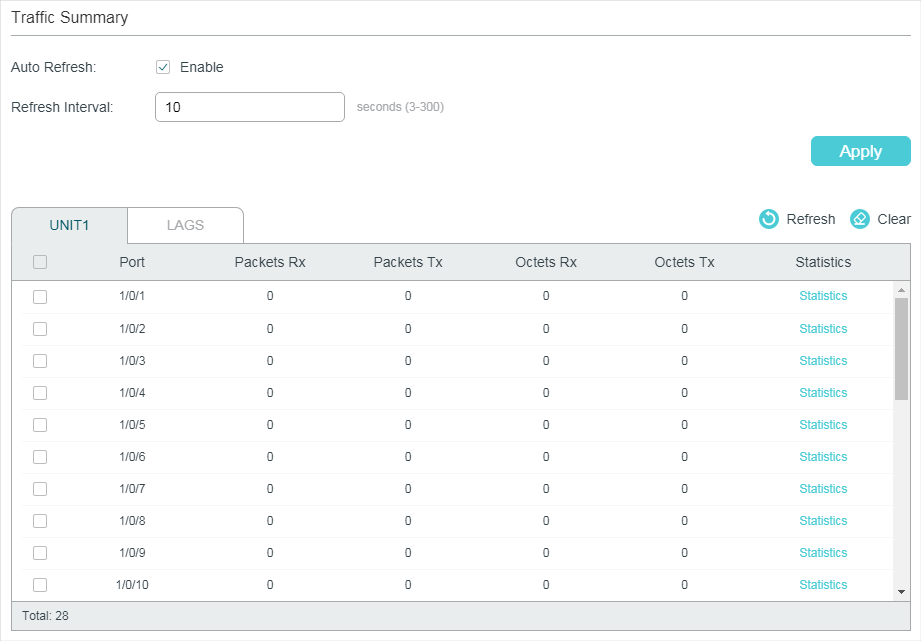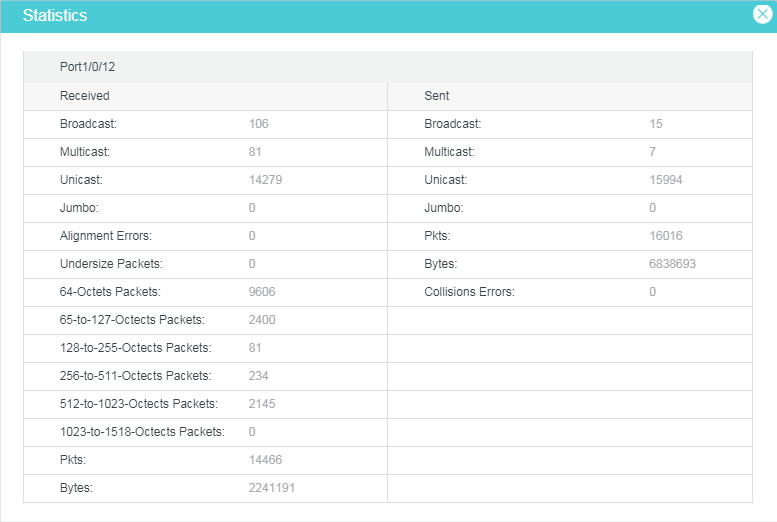Monitoring Traffic
CHAPTERS
2. Appendix: Default Parameters
|
|
This guide applies to: T1500G-8T v2 or above, T1500G-10PS v2 or above, T1500G-10MPS v2 or above, T1500-28PCT v3 or above, T1600G-18TS v2 or above, T1600G-28TS v3 or above, T1600G-28PS v3 or above, T1600G-52TS v3 or above, T1600G-52PS v3 or above, T1700X-16TS v3 or above, T1700G-28TQ v3 or above, T2500G-10TS v2 or above, T2600G-18TS v2 or above, T2600G-28TS v3 or above, T2600G-28MPS v3 or above, T2600G-28SQ v1 or above, T2600G-52TS v3 or above. |
With Traffic Monitor function, you can monitor each port’s traffic information, including the traffic summary and traffic statistics in detail.
1.1Using the GUI
Choose the menu MAINTENANCE > Traffic Monitor to load the following page.
Figure 1-1 Traffic Summary

Follow these steps to view the traffic summary of each port:
1)To get the real-time traffic summary, enable Auto Refresh, or click Refresh.
|
Auto Refresh: |
With this option enabled, the switch will automatically refresh the traffic summary. |
|
Refresh Interval: |
Specify the time interval for the switch to refresh the traffic summary. |
2)In the Traffic Summary section, click UNIT1 to show the information of the physical ports, and click LAGS to show the information of the LAGs.
|
Packets Rx: |
Displays the number of packets received on the port. Error packets are not counted. |
|
Packets Tx: |
Displays the number of packets transmitted on the port. Error packets are not counted. |
|
Octets Rx: |
Displays the number of octets received on the port. Error octets are counted. |
|
Octets Tx: |
Displays the number of octets transmitted on the port. Error octets are counted . |
To view a port’s traffic statistics in detail, click Statistics on the right side of the entry.
Figure 1-2 Traffic Statistics

|
Received: |
Displays the detailed information of received packets. Broadcast: Displays the number of valid broadcast packets received on the port. Error frames are not counted. Multicast: Displays the number of valid multicast packets received on the port. Error frames are not counted. Unicast: Displays the number of valid unicast packets received on the port. Error frames are not counted. Jumbo: Displays the number of valid jumbo packets received on the port. Error frames are not counted. Alignment Errors: Displays the number of the received packets that have a Frame Check Sequence (FCS) with a non-integral octet (Alignment Error). The size of the packet is between 64 bytes and 1518 bytes. Undersize Packets: Displays the number of the received packets (excluding error packets) that are less than 64 bytes long. 64-Octets Packets: Displays the number of the received packets (including error packets) that are 64 bytes long. 65-to-127-Octects Packets: Displays the number of the received packets (including error packets) that are between 65 and 127 bytes long. 128-to-255-Octects Packets: Displays the number of the received packets (including error packets) that are between 128 and 255 bytes long. 256-to-511-Octects Packets: Displays the number of the received packets (including error packets) that are between 256 and 511 bytes long. 512-to-1023-Octects Packets: Displays the number of the received packets (including error packets) that are between 512 and 1023 bytes long. 1023-to-1518-Octects Packets: Displays the number of the received packets (including error packets) that are between 512 and 1023 bytes long. Pkts: Displays the number of packets received on the port. Error packets are not counted. Bytes: Displays the number of bytes received on the port. Error packets are not counted. |
|
Sent: |
Displays the detailed information of sent packets. Broadcast: Displays the number of valid broadcast packets transmitted on the port. Error frames are not counted. Multicast: Displays the number of valid multicast packets transmitted on the port. Error frames are not counted. Unicast: Displays the number of valid unicast packets transmitted on the port. Error frames are not counted. Pkts: Displays the number of packets transmitted on the port. Error packets are not counted. Bytes: Displays the number of bytes transmitted on the port. Error packets are not counted. Collisions: Displays the number of collisions experienced by a half-duplex port during packet transmissions. |
1.2Using the CLI
On privileged EXEC mode or any other configuration mode, you can use the following command to view the traffic information of each port or LAG:
|
show interface counters [ fastEthernet port | gigabitEthernet port | ten-gigabitEthernet port | port-channel port-channel-id ] port: The port number. port-channel-id : The group number of the LAG. If you enter no port number or group number, the information of all ports and LAGs will be displayed. The displaying information includes: Tx Collisions: Displays the number of collisions experienced by a port during packet transmissions. Tx Ucast / Tx Mcast / Tx Bcast / Tx Jumbo: Displays the number of valid unicast / multicast / broadcast / jumbo packets transmitted on the port. Error frames are not counted. Tx Pkts: Displays the number of packets transmitted on the port. Error packets are not counted. Tx Bytes: Displays the number of bytes transmitted on the port. Error packets are not counted. Rx Ucast / Rx Mcast / Rx Bcast / Rx Jumbo: Displays the number of valid unicast / multicast / broadcast / jumbo packets received on the port. Error frames are not counted. Rx Alignment: Displays the number of the received packets that have a Frame Check Sequence (FCS) with a non-integral octet (Alignment Error). The size of the packet is between 64 bytes and 1518 bytes. Rx UnderSize: Displays the number of the received packets (excluding error packets) that are less than 64 bytes long. Rx 64Pkts: Displays the number of the received packets (including error packets) that are 64 bytes long. Rx 65-127Pkts: Displays the number of the received packets (including error packets) that are between 65 and 127 bytes long. Rx 128-255Pkts: Displays the number of the received packets (including error packets) that are between 128 and 255 bytes long. Rx 256-511Pkts: Displays the number of the received packets (including error packets) that are between 256 and 511 bytes long. Rx 512-1023Pkts: Displays the number of the received packets (including error packets) that are between 512 and 1023 bytes long. Rx 1024-1518Pkts: Displays the number of the received packets (including error packets) that are between 1024 and 1518 bytes long. Rx Pkts: Displays the number of packets received on the port. Error packets are not counted. Rx Bytes: Displays the number of bytes received on the port. Error packets are not counted. |
Table 2-1Traffic Statistics Monitoring
|
Parameter |
Default Setting |
|
Traffic Summary |
|
|
Auto Refresh |
Disable |
|
Refresh Rate |
10 seconds |